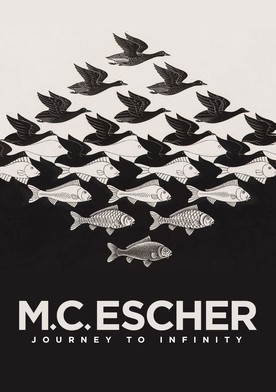More reviews for “M.C. Escher: Journey to Infinity”

More reviews for “M.C. Escher: Journey to Infinity”

The big shock in Robin Lutz’s documentary, M.C. ESCHER: Journey to Infinity, comes early. The creator of so many mind-bending woodcuts didn’t consider himself an artist. When rock star Graham Nash told the creator of all those mind-bending images that he was an artist, Escher refused the label and called himself a mathematician. Believe it or not, that actually makes sense. One would have to understand considerable geometry, algebra, and probably trigonometry to create those pictures….
The camera tracks down what is unmistakably a young woman’s naked back as the voice of Stephen Fry, throwing himself into an amusing dudgeon, reads from the letters of the puzzle print-maker M.C. Escher, griping about “the hippies in San Francisco” who are “printing my work clandestinely,” turning it into “place mats” and color-tinting it for posters and what not….
As I recall, one of the first things we learn from the new documentary about fabled artist M.C. Escher (1898-1972) is that the fellow, who knew a few things about movies and animation, as well as about art and mathematics, felt that “There is only one person in the world who could make a really good movie about my prints: myself.” …
Despite Graham Nash’s words at the conclusion of Robin Lutz’s documentary M.C. Escher: Journey to Infinity stating that the world is destined to reappreciate the artist’s work, the fact that it’s taken three years for the film to become available in the United States seemingly proves the opposite. As the pop culture footage during the end credits reveals, however, it might just be that Nash was underestimating how important Escher’s art already was...
M.C. Escher — he of never-ending stairwells, fish morphing into flowers, hands drawing one another, expert use of glass globes, and math-minded imagineer of infinite nesting universes — is an iconic image-maker who is almost universally recognized outside the art world, criminally unrepresented in the art world canon, and, it turns out, not at all the sort of person one might suppose him to be.…
…. M.C. Escher: Journey to Infinity takes a largely chronological approach to telling Escher’s life. It traces his upbringing in a wealthy Dutch family at the turn of the century and his time studying at the Haarlem School of Architecture and Decorative Arts. During his youth, he would revel in the overwhelming quality of the organ music at St. Bartholomew’s church in Haarlem, and the layers of otherworldly sounds he heard there would inform his later interest in creating illimitable tessellations, paradoxical architectures, and other scenes that produce dizzying and dazzling effects….
Robin Lutz’s visually compelling, inventive M.C. Escher: Journey to Infinity strikes just the right note of whimsy in exploring the graphic art of a talent known for his sense of the whimsical. Just as his compatriots Bosch, Rembrandt, Vermeer and Van Gogh, created new ways of seeing with, respectively, surrealistic symbolism, chiaroscuro, photorealist style and Post-Impressionism, the Dutch Escher expanded the sense of perception on the flat “limited plane” of paper he imprinted with his unique “visualization of infinity.” …
Robin Lutz has created a singular journey into the deep waves of math and art conjured forth by Dutch graphic artist M.C. Escher in M.C. Escher: Journey to Infinity. The film looks at Escher’s early life and education. He was born in Leeuwarden as the youngest son, with his family later moving to Arnhem, where he spent most of his youth. He was an uninspired student but managed to get into the School of Architecture and Decorative Arts in Haarlem. Once there, he quickly shifted his focus to graphic arts….
“M.C. Escher: Journey to Infinity” succeeds where so many documentaries about artists fail: It provides real insight into the art. It’s a welcome trip for those fascinated by his iconic, mind-bending depictions of illusions, evolutions and eternal cycles…
Providing some orientation for the disorienting work of the Dutch printmaker M.C. Escher (1898-1972), the documentary “M.C. Escher: Journey to Infinity” takes its cues from Escher’s writings, which it uses as narration. (Stephen Fry’s voice-over applies an unwarranted grandiosity to these self-effacing musings.)
M.C. Escher: Journey to Infinity,” the exquisite new documentary about one of the most inventive graphic artists of all times, beautifully captures why he has been and continues to be revered. Directed by Robin Lutz, it follows a playbook created by Escher himself when he stated, “I fear that there is only one person in the world who could make a really good movie about my prints: myself.” Using that very framework, Lutz and her co-writer Marijnke de Jong masterfully create this film from Escher’s own journals and letters with Stephen Fry voicing the words of Escher…..
Biography
M.C.Escher
Maurits Cornelis Escher (1898-1972) is one of the world’s most famous graphic artists. His art is enjoyed by millions of people all over the world, as can be seen on the many web sites on the internet. He is most famous for his so-called impossible constructions, such as Ascending and Descending, Relativity, his Transformation Prints, such as Metamorphosis I, Metamorphosis II and Metamorphosis III, Sky & Water I or Reptiles. But he also made some wonderful, more realistic work during the time he lived and traveled in Italy.
